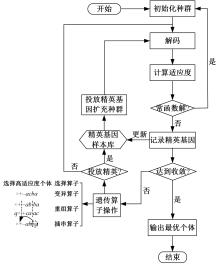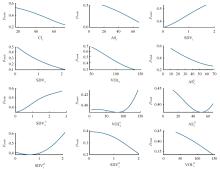Journal of Jilin University(Engineering and Technology Edition) ›› 2024, Vol. 54 ›› Issue (3): 719-726.doi: 10.13229/j.cnki.jdxbgxb.20221029
Real⁃time crash prediction of elevated expressway based on gene expression programming algorithm
Xiao-chi MA1,2,3( ),Jian LU1,2,3(
),Jian LU1,2,3( )
)
- 1.Jiangsu Key Laboratory of Urban ITS,Southeast University,Nanjing 211189,China
2.Jiangsu Province Collaborative Innovation Center of Modern Urban Traffic Technologies,Southeast University,Nanjing 211189,China
3.School of Transportation,Southeast University,Nanjing 211189,China
CLC Number:
- U491.31
| 1 | Hossain M, Abdel-Aty M, Quddus M A, et al. Real-time crash prediction models: state-of-the-art, design pathways and ubiquitous requirements[J]. Accident Analysis & Prevention, 2019, 124: 66-84. |
| 2 | Mannering F, Bhat C R, Shankar V, et al. Big data, traditional data and the tradeoffs between prediction and causality in highway-safety analysis[J]. Analytic Methods in Accident Research, 2020, 25: No. 100113. |
| 3 | Abdel-Aty M, Uddin N, Pande A, et al. Predicting freeway crashes from loop detector data by matched case-control logistic regression[J]. Transportation Research Record, 2004, 1897(1): 88-95. |
| 4 | 郑来, 顾鹏, 卢健. 基于T-S模糊故障树和贝叶斯网络的重特大交通事故成因分析[J]. 交通信息与安全, 2021, 39(4): 43-51. |
| Zheng Lai, Gu Peng, Lu Jian. A cause analysis of extraordinarily severe traffic crashes based on T-S fuzzy fault tree and bayesian network[J]. Journal of Transport Information and Safety, 2021, 39(4): 43-51. | |
| 5 | Yu R J, Zheng Y, Abdel-Aty M, et al. Exploring crash mechanisms with microscopic traffic flow variables: a hybrid approach with latent class logit and path analysis models[J]. Accident Analysis & Prevention, 2019, 125: 70-78. |
| 6 | Li L C, Sheng X, Du B, et al. A deep fusion model based on restricted Boltzmann machines for traffic accident duration prediction[J]. Engineering Applications of Artificial Intelligence, 2020, 93: No. 103686. |
| 7 | Wang L, Abdel-Aty M, Lee J, et al. Analysis of real-time crash risk for expressway ramps using traffic, geometric, trip generation, and socio-demographic predictors[J]. Accident Analysis & Prevention, 2019, 122: 378-384. |
| 8 | 陈荔, 李聪颖, 詹立, 等. 城市道路交通事故形态影响因素分析与预测[J]. 长安大学学报: 自然科学版, 2022, 42(4): 98-107. |
| Chen Li, Li Cong-ying, Zhan Li, et al. Influencing factors analysis and prediction of urban road traffic accident patterns[J]. Journal of Chang'an University (Natural Science Edition), 2022, 42(4): 98-107. | |
| 9 | Yu R J, Abdel-Aty M. Utilizing support vector machine in real-time crash risk evaluation[J]. Accident Analysis & Prevention, 2013, 51: 252-259. |
| 10 | Guo Miao, Zhao Xiao-hua, Yao Ying, et al. A study of freeway crash risk prediction and interpretation based on risky driving behavior and traffic flow data[J]. Accident Analysis & Prevention, 2021, 160: No. 106328. |
| 11 | Eboli L, Mazzulla G, Pungillo G. How to define the accident risk level of car drivers by combining objective and subjective measures of driving style[J]. Transportation Research Part F: Traffic Psychology and Behaviour, 2017, 49: 29-38. |
| 12 | Dingus T A, Guo F, Lee S, et al. Driver crash risk factors and prevalence evaluation using naturalistic driving data[J]. Proceedings of the National Academy of Sciences of the United States of America, 2016, 113(10): 2636-2641. |
| 13 | 王海晓, 李永翔, 丁旭, 等. 基于边缘智能的城市下穿隧道车辆行车安全预测[J]. 吉林大学学报: 工学版, 2022, 52(6): 1337-1343. |
| Wang Hai-xiao, Li Yong-xiang, Ding Xu, et al. Traffic safety prediction of urban underpass tunnel vehicles based on edge intelligence[J]. Journal of Jilin University (Engineering and Technology Edition), 2022, 52(6): 1337-1343. | |
| 14 | 高珍, 高屹, 余荣杰, 等. 连续数据环境下的道路交通事故风险预测模型[J]. 中国公路学报, 2018, 31(4): 280-287. |
| Gao Zhen, Gao Yi, Yu Rong-jie, et al. Road crash risk prediction model for continuous streaming data environment[J]. China Journal of Highway and Transport, 2018, 31(4): 280-287. | |
| 15 | 李思瑶. 考虑交通异质性的城市快速路事故预测方法[D]. 武汉: 武汉理工大学能源与动力工程学院, 2020. |
| Li Si-yao. Study on urban expressway crash prediction method considering traffic heterogeneity[D]. Wuhan: School of Energy and Power Engineering, Wuhan University of Technology, 2020. | |
| 16 | Xu Chuan, Wang Xue-song, Yang Hong, et al. Exploring the impacts of speed variances on safety performance of urban elevated expressways using GPS data[J]. Accident Analysis And Prevention, 2019, 123: 29-38. |
| 17 | Xu Cheng-cheng, Liu Pan, Wang Wei, et al. Real-time identification of traffic conditions prone to injury and non-injury crashes on freeways using genetic programming[J]. Journal of Advanced Transportation, 2016, 50(5): 701-716. |
| 18 | Candida F. Gene expression programming: a new adaptive algorithm for solving problems[J]. Complex Systems, 2000, 13(2): 87-129. |
| 19 | Yang Kui, Yu Rong-jie, Wang Xue-song, et al. How to determine an optimal threshold to classify real-time crash-prone traffic conditions?[J]. Accident Analysis & Prevention, 2018, 117: 250-261. |
| 20 | Behnood A, Al-Bdairi N S S. Determinant of injury severities in large truck crashes: a weekly instability analysis[J]. Safety Science, 2020, 131: No. 104911. |
| 21 | Chand A, Jayesh S, Bhasi A B. Road traffic accidents: an overview of data sources, analysis techniques and contributing factors[J]. Materials Today: Proceedings, 2021, 47: 5135-5141. |
| [1] | ZONG Fang, LU Feng-rui, TANG Ming, LYU Jian-yu, WU Ting. Impact of habit and traffic condition on travel route selection [J]. 吉林大学学报(工学版), 2018, 48(4): 1023-1028. |
| [2] | CHEN Yu,TANG Chang-jie,ZHU Ming-fang,DAI Shu-cheng,ZHU Rui,JIANG Yue,LI Chuan. FactorGEP: a novel factorization of polynomial algorithm based on GEP with gene reduction strategy [J]. 吉林大学学报(工学版), 2009, 39(06): 1612-1617. |
| [3] | JIANG Yue, TANG Chang-jie, LI Chuan, LI Sheng-zhi, YE Shang-yu, WU Jiang . Identification of Hammerstein model based on gene expression programming [J]. 吉林大学学报(工学版), 2008, 38(05): 1114-1119. |
|
||



